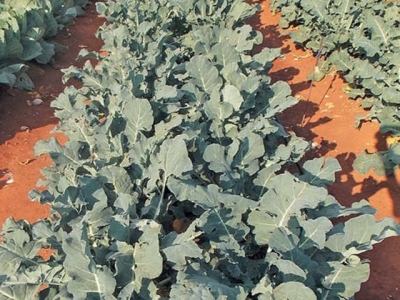How to fertilise a crop correctly

Readers frequently ask me for specific fertiliser programmes for their crops. I would happily oblige if all crops were the same!
These brassicas at my facility are growing in no-till soil. They have had no fertilisation apart from a legume cover crop two years ago. This can only be done if the organic status and soil life are healthy enough to ensure that recycling of nutrients takes place. Photo: Bill Kerr
Unfortunately, each crop is different because each land is unique. ‘One-size-fits-all’ programmes are always risky.
Each land has its own reserve of nutrients and this must be taken into account when determining a crop’s fertiliser requirement. This is why it’s necessary to have the soil analysed.
Only once you have these results can you determine how to fertilise according to the specific needs of the crop.
The nutrients in the soil are bound in clay colloids and may not be readily available to the plants due to the soil pH or the action of certain minerals. As a result, the nutrients must first be ‘altered’ chemically or biologically before the plants can use them.
Phosphorous, for example, can be in the form of iron phosphate, aluminium phosphate or manganese phosphate. In any of these states, it is unavailable to plants. Fertiliser companies therefore finely grind rock phosphate and treat it chemically.
Applied to a crop, this makes phosphate available to plants. The duration of this availability will depend largely on the soil’s pH.
Plants convert the sun’s energy into sugary substances in their leaves and exude these from their roots to supply soil microbes. About 30% of the energy used by the plants goes into feeding microbes, and these in turn make nutrients available to the plant.
If we don’t consider the value of a healthy microbial environment in the soil, the plants certainly do!
Organic content also acts as a buffer. A hectare of good soil with a healthy organic content can contain up to 5t of soil organisms. These represent a reservoir of nutrients that are constantly recycled and provide food for plants.
A healthy, balanced quantity of minerals in the soil is good for all crops, especially vegetables. Once you have achieved this, you need only ‘top-up’ where necessary, irrespective of the crop.
More soil organisms, fewer worries
The higher the organic content of the soil and the accompanying soil life, the less you need to know about soil fertility and the less important mineral imbalances become.
Farmers (and fertiliser companies!) place too much emphasis on establishing the precise quantity of fertiliser to apply to each crop instead of getting the soil properly fertile in the first place.
How soon you can achieve this depends on your operation. Field crops do not always have enough of a profit margin for a farmer to fast-track the process but the principles remain the same.
Soil health
As a vegetable farmer, you have too much to lose by ignoring soil fertility. Focus on improving soil health as soon as possible – by increasing organic content, achieving the correct mineral balance and tilling as little as possible.
Bill Kerr is a vegetable specialist and a breeder of a range of vegetables
Có thể bạn quan tâm
 How to control cucurbit viruses
How to control cucurbit viruses It is also important to control aphids as these are the primary vectors of viruses. Apart from spreading viruses, they are up to no good anyway!
 10 Smart Ways to Garden on the Cheap
10 Smart Ways to Garden on the Cheap You don’t have to spend obscene amounts of money to grow your own food. Here are some tips for a spectacular backyard garden without the exorbitant expenses.
 What Does a Seed Farmer Do?
What Does a Seed Farmer Do? Saving seed from this year’s crop in order to sow it the following spring is a romantic idea, but most modern-day farmers don’t have time for it